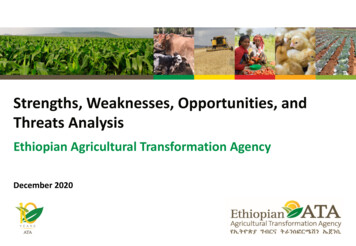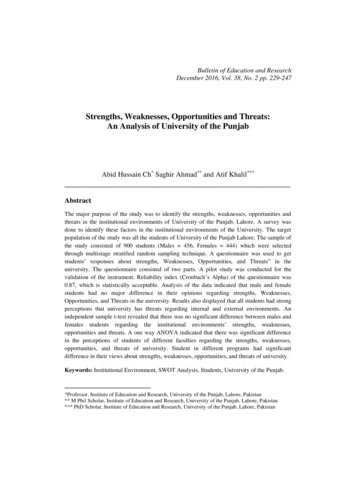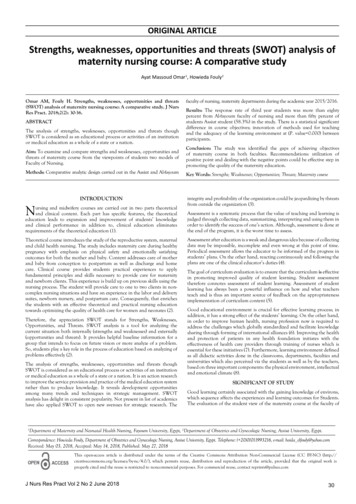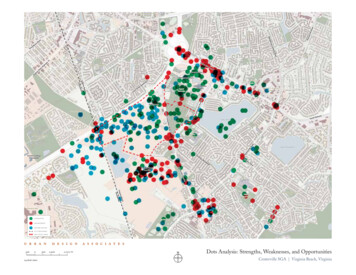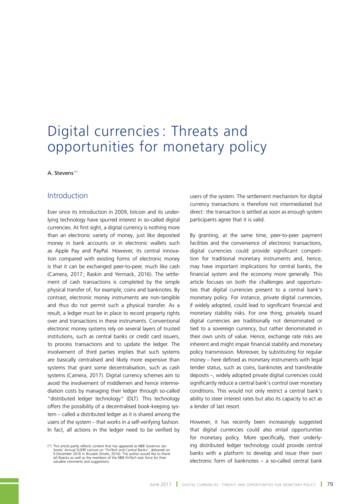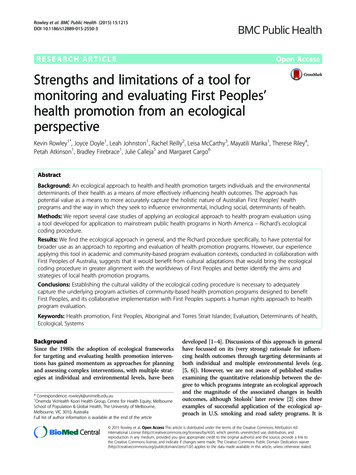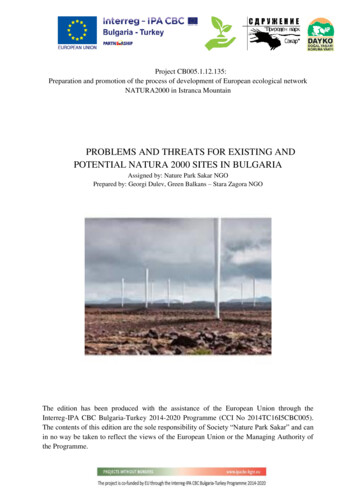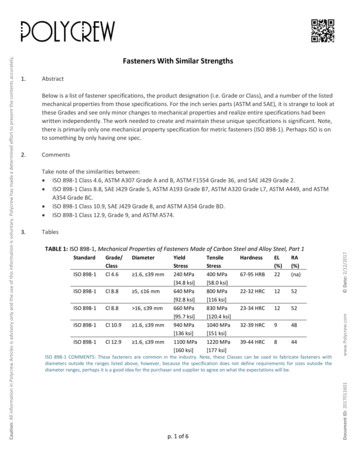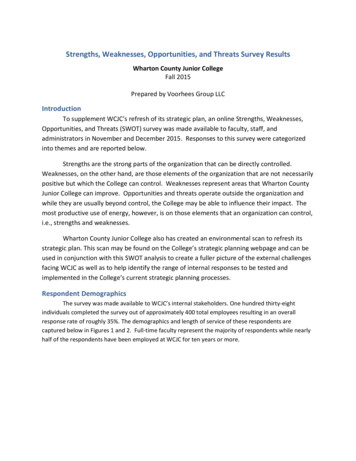
Transcription
Strengths, Weaknesses, Opportunities, and Threats Survey ResultsWharton County Junior CollegeFall 2015Prepared by Voorhees Group LLCIntroductionTo supplement WCJC’s refresh of its strategic plan, an online Strengths, Weaknesses,Opportunities, and Threats (SWOT) survey was made available to faculty, staff, andadministrators in November and December 2015. Responses to this survey were categorizedinto themes and are reported below.Strengths are the strong parts of the organization that can be directly controlled.Weaknesses, on the other hand, are those elements of the organization that are not necessarilypositive but which the College can control. Weaknesses represent areas that Wharton CountyJunior College can improve. Opportunities and threats operate outside the organization andwhile they are usually beyond control, the College may be able to influence their impact. Themost productive use of energy, however, is on those elements that an organization can control,i.e., strengths and weaknesses.Wharton County Junior College also has created an environmental scan to refresh itsstrategic plan. This scan may be found on the College’s strategic planning webpage and can beused in conjunction with this SWOT analysis to create a fuller picture of the external challengesfacing WCJC as well as to help identify the range of internal responses to be tested andimplemented in the College’s current strategic planning processes.Respondent DemographicsThe survey was made available to WCJC’s internal stakeholders. One hundred thirty-eightindividuals completed the survey out of approximately 400 total employees resulting in an overallresponse rate of roughly 35%. The demographics and length of service of these respondents arecaptured below in Figures 1 and 2. Full-time faculty represent the majority of respondents while nearlyhalf of the respondents have been employed at WCJC for ten years or more.
2Figure 1. Which best describes your role at the rofessional Staff17%Part-TimeFaculty9%Figure 2. How long have you been affiliated with WCJC?One year orless6%Two to threeyears15%Ten years ormore47%Seven tonine years12%Four to sixyears20%
3StrengthsQuality and program variety. The most common strengths mentioned by all employeegroups was the quality and variety of programs offered. There were numerous comments madeabout the high quality of the various vocational/career technical education certificate grantingprograms (e.g., nursing, dental hygiene, welding, automotive and cosmetology), and how theseprograms respond to the job market demands. Moreover, these programs are reported to behighly regarded in the community, and the students who graduate from these programs areperceived to be the top in their fields.Student-centered. The next most common themes, also found across all employeegroups under Strengths, was student centeredness including personal and individual attentionthat the students receive from faculty, staff and administrators. The perception exists that thecollege does all it can to support students through services and in meeting their academic andcareer goals, and the small class sizes lend themselves to connecting with the students. Therealso appears to be genuine interest by all employees in the success of their students.Quality of Instruction. Both faculty and professional staff believed that one of thecollege’s strengths is the quality of instruction. The faculty at WCJC are perceived as talented,dedicated, and highly competent. They perceive themselves as caring about students andstudent success.Positive learning and work environment. There was also mention of the positivelearning and work environment as an area of strength at the college. This was particularlyprevalent among the professional staff and faculty. Faculty also believe that there are strongdepartment heads, and that the college supports them and their programs, and there is a spiritof cooperation. Respondents also believe there has been financial stability and a sense of prideat the College. The professional staff believes that employees are genuinely positive, and careabout each other, and are connected to students.WeaknessesEnvironment and morale. A frequent theme across all employee groups is morale andthe campus environment. Many felt there is a general sense of dissatisfaction, and low moraleamong employees. Some stated that there is distrust, uncooperative attitudes, and disrespectamong groups, and across departments. There were claims of infighting, and lack ofcohesiveness within departments, as well as a general disconnect between the administrationand the faculty. Faculty in particular stated that they felt undervalued, and most pointed to thecomparatively low salaries, as well as the lack of increases in salaries as a factor that has beencontributing to the low morale.
4Technology and IT support. Many commented on the need to update the technology at thecampuses; upgrade computers, add smart boards to the classrooms, improve the email system,and upgrade the infrastructure to support greater bandwidth capacity for things like studentportals, and additional online classes. The belief is that the college is falling behind other Texascolleges and losing its competitiveness (and students) as a result. In addition to this, the ITdepartment perceives that it is not adequately staffed to accommodate all of the needs of thecollege, and lacks the necessary responsiveness to support faculty in particular.Facilities. Although not as prevalent, there was mention of the need to improve someof the facilities. This included the buildings (e.g., increase classroom and lab space), as well asreplace old furnishings, improve the lighting (at the Richmond campus), and add more signage.Marketing. Another predominant theme is the perceived need for more marketing. Inparticular, faculty believe that there is a lack of marketing of their instructional programs thatwould lead to increase enrollments. Additional comments and suggestions were made topublicize the small campus/country feel of the college, and the reputation for qualityeducation. Some suggested advertising more broadly (e.g., television ads, and billboards), andcreating some campaigns that build excitement about attending the college.Communication. An additional theme expressed across all employee groups was theneed for improved communication in its various forms. It is not unusual in the VoorheesGroup’s experience for college constituents to be concerned with communications as auniversal theme. Some at WCJC believe that the communication from the leadership is nottransparent, nor frequent enough, and often too formal, and top-down. Comments were alsomade about the poor quality of the WCJC website; unclear information, outdated forms, andlinks that don’t work. Other comments were made about the numerous committee meetingsthat seem to be unproductive because of the lack of information shared at the meetings.Leadership and planning. One weaknesses mentioned primarily by professional staffand support staff was leadership and planning. This included the need for training andmentoring of leaders at the college especially in communication. Lack of, or unclearcommunication by the leadership was the area mentioned most frequently. It was also notedthat there needs to be better alignment between the administrations’ decisions and the needsof the departments, as well as a call for improving collaboration between the two. Also notedwas the lack of a clear vision for growth and expansion of the various campuses, as well as thegeneral need for better strategic planning.Student services and activities. One of the more common themes among faculty andsupport staff was improving student services and adding more student activities. Suggestionsfor improving customer service and processes in the student services departments (e.g.,
5financial aid, counseling, registration) included; responding to telephone calls more readily,adding more advisors and counselors, and extending the office hours to accommodate eveningstudents. Few concrete suggestions were made for increasing the student activities on campus,although adding more intramural sports, as well as better planned and organized socialactivities for the students were mentioned by several respondents.OpportunitiesPopulation growth and expansion. The most common theme under opportunities waspopulation growth within the college’s service area, as well as the perceived need to expandcollege programs and facilities in order to accommodate this growth. Many comments acrossall employee groups referenced the large population growth within the Fort Bend county, andSugar Land and Richmond areas, which opens up a variety of possibilities for facilities expansionand enhancements at the campuses (e.g., the tech center in Richmond). Along with the growthof the population in the area, it was noted that there will be a need for additional and qualifiedworkforce for which WCJC can provide training. Programs such as the Associate Degree inNursing, petrochemical, healthcare, and other vocational programs (e.g., welding, cosmetologyand LVN) are perceived as growth areas as well continuing education classes, ESL and transitionskills classes.Reputation. The second most common area for opportunities that were suggested by allemployee groups across the college is related to the college’s reputation. There were numerouscomments about the college’s positive reputation in the community and the dedication ofcollege employees to student success. The college has a reputation also of offering a smallcampus environment, yet located conveniently within a short distance to a large city. Thefinancial benefits were also mentioned in terms of the affordability of a quality educationstudents receive at the college.Economic shifts and marketing. The other area of opportunity that was mentionedparticularly by faculty and professional staff was the downturn of the oil-based economy in thestate and the opportunity to re-train the workforce. Even if reduced oil demand is only a shortterm phenomenon, jobs in the oil industry are now being reduced and people are looking toshift careers and require training to do so. Many see this as an opportunity to market thevocational and short-term programs more heavily. Marketing the technical programs inparticular would serve the college and the community well. Equally important are newprograms that need to be developed to respond to the demands of the new economy.Additional marketing to underserved populations that need training in the new economy wasalso mentioned.
6Industry, community, and university partnerships. Another common theme underopportunities was partnerships. In particular, partnerships with industry to help determine thechanging workforce needs is a perceived need to provide professional growth and developmentopportunities for the students. Partnerships with the four year universities (e.g., University ofHouston) were also noted as an important opportunity that has not yet been fully tapped.Community partnerships in general were also mentioned as a way to utilize external resourcesavailable in the community.Grants and scholarships. Federal grant funding opportunities, and scholarships werenoted by faculty as opportunities. Grants were mentioned as a way to support program growthin the STEM areas in particular, and scholarships were mentioned as a general benefit to WCJCstudents.ThreatsCompetition. The most common threat reported across all employee groups wascompetition. The most frequently mentioned competitor is the Texas State Technical College(TSTC) campus scheduled to open in the Fort Bend/Richmond area in Fall 2016. TSTC has thepotential to attract students away from the Wharton County Community College Richmondcampus’s career and technical programs. There also are other technical and non-technicalproviders that serve the eastern portions of Fort Bend County and the surrounding area withthe same or similar programs as Wharton. These are perceived as direct competition forstudents, and thereby a threat to WCJC’s enrollment. Additionally, there is the perception thatthe University of Houston’s growing need from classroom space at their Sugar Land campusmay eventually lead to a termination of WCJC’s facilities agreement with the possibility oflosing future students. To counteract this possibility several respondents suggested thatpartnerships between the U of H and Wharton be strengthened.Safety and security. The second most prevalent threat, mentioned frequently by faculty,was safety and security on the campuses, especially new legislation that allows students andothers to carry guns on campus. There is also concern that the security at the campuses is notadequate (e.g., no cameras, unlocked side entrance doors, free access to instructors’ offices,and poor emergency communication systems). The need for emergency response training forfaculty and security personnel was frequently mentioned.Funding. The third most common threat mentioned across all employee groups wasstate appropriations. It was noted that there is a lack of funding currently and that funding lostduring the recession was unlikely to return to previous levels. Adequate funding to develop
7and enhance programs, or upgrade facilities and technology, is a perceived need to trigger thecollege’s ability to compete for students.
portals, and additional online classes. The belief is that the college is falling behind other Texas colleges and losing its competitiveness (and students) as a result. In addition to this, the IT . The most frequently mentioned competitor is the Texas State Technical College (TSTC) campu
